Review of the Newly Developed, Mobile Optical Sensors for Real-Time Measurement of the Atmospheric Particulate Matter Concentration
Abstract
1. Introduction
2. Particulate Matter Characteristics and Legislation Emission
2.1. Particulate Matter Effects on Health and the Environment
2.2. Particulate Matter Sources and Regulation Requirements
3. Overview of the Mobile Optical PM Sensors
4. Optical Particle Counter Principle
4.1. Light Scattering Theory
4.2. Optical Particle Counters Based on the Scattering Theory
4.3. Coincidence in Optical Particle Counters
5. Optical Particle Counters Based on Scattering Techniques
5.1. Smartphone-Based OPC
5.2. Optical Particle Counter Based on the Parabolic Collector (Sub-Micron Particle Counter) CPC-Based OPC
5.3. Silicon-Based OPC (MEMS PM Monitor)
5.4. Fresnel Ring Lens-Based OPC and the Inertial Filtering
5.5. Drilled Lens-Based OPC
6. Optical Particle Sensors Based on Image Processing Techniques
6.1. Holographic Particle Counter
6.2. Filter-Based Particle Sensor
6.3. Dust Deposition-Based Particle Sensor
7. Comparison and Discussion
8. Conclusions
Funding
Institutional Review Board Statement
Informed Consent Statement
Data Availability Statement
Conflicts of Interest
References
- Ghorani-Azam, A.; Riahi-Zanjani, B.; Balali-Mood, M. Effects of air pollution on human health and practical measures for prevention in Iran. J. Res. Med. 2016, 21, 65. [Google Scholar]
- Robinson, D.L. Air pollution in Australia: Review of costs, sources and potential solutions. Health Promot. J. Aust. 2005, 16, 213–220. [Google Scholar] [CrossRef]
- WHO. World Health Assembly Closes, Passing Resolutions on Air Pollution and Epilepsy. Available online: https://www.who.int/mediacentre/news/releases/2015/wha-26-may-2015/en/ (accessed on 1 December 2020).
- EPA. Criteria Air Pollutants. Available online: https://www.epa.gov/criteria-air-pollutants (accessed on 1 December 2020).
- Bennett, J.; Davy, P.; Trompetter, B.; Wang, Y.; Pierse, N.; Boulic, M.; Phipps, R.; Howden-Chapman, P. Sources of indoor air pollution at a New Zealand urban primary school; a case study. Atmos. Pollut. Res. 2019, 10, 435–444. [Google Scholar] [CrossRef]
- Lelieveld, J.; Evans, J.S.; Fnais, M.; Giannadaki, D.; Pozzer, A. The contribution of outdoor air pollution sources to premature mortality on a global scale. Nature 2015, 525, 367–371. [Google Scholar] [CrossRef] [PubMed]
- Thorpe, A.; Harrison, R.M. Sources and properties of non-exhaust particulate matter from road traffic: A review. Sci. Total Environ. 2008, 400, 270–282. [Google Scholar] [CrossRef] [PubMed]
- Anderson, J.O.; Thundiyil, J.G.; Stolbach, A. Clearing the air: A review of the effects of particulate matter air pollution on human health. J. Med. Toxicol. 2012, 8, 166–175. [Google Scholar] [CrossRef] [PubMed]
- Kappos, A.D.; Bruckmann, P.; Eikmann, T.; Englert, N.; Heinrich, U.; Höppe, P.; Koch, E.; Krause, G.H.; Kreyling, W.G.; Rauchfuss, K.; et al. Health effects of particles in ambient air. Int. J. Hyg. Environ. Health 2004, 207, 399–407. [Google Scholar] [CrossRef]
- Satsangi, D.P.; Agarwal, A.K. Particulate matter and its impact on human health in urban settings. In Methanol and the Alternate Fuel Economy; Springer: Berlin/Heidelberg, Germany, 2019; pp. 213–231. [Google Scholar]
- Kelly, F.J.; Fussell, J.C. Size, source and chemical composition as determinants of toxicity attributable to ambient particulate matter. Atmos. Environ. 2012, 60, 504–526. [Google Scholar] [CrossRef]
- United States Environmental Protection Agency. Particulate Matter (PM) Pollution. Available online: https://www.epa.gov/pm-pollution (accessed on 2 October 2020).
- Shridhar, V.; Khillare, P.S.; Agarwal, T.; Ray, S. Metallic species in ambient particulate matter at rural and urban location of Delhi. J. Hazard. Mater. 2010, 175, 600–607. [Google Scholar] [CrossRef]
- Sarnat, S.E.; Klein, M.; Sarnat, J.A.; Flanders, W.D.; Waller, L.A.; Mulholland, J.A.; Russell, A.G.; Tolbert, P.E. An examination of exposure measurement error from air pollutant spatial variability in time-series studies. J. Expo. Sci. Environ. Epidemiol. 2010, 20, 135–146. [Google Scholar] [CrossRef]
- Gozzi, F.; della Ventura, G.; Marcelli, A. Mobile monitoring of particulate matter: State of art and perspectives. Atmos. Pollut. Res. 2016, 7, 228–234. [Google Scholar] [CrossRef]
- Van den Bossche, J.; Peters, J.; Verwaeren, J.; Botteldooren, D.; Theunis, J.; de Baets, B. Mobile monitoring for mapping spatial variation in urban air quality: Development and validation of a methodology based on an extensive dataset. Atmos. Environ. 2015, 105, 148–161. [Google Scholar] [CrossRef]
- Patton, A.P.; Perkins, J.; Zamore, W.; Levy, J.I.; Brugge, D.; Durant, J.L. Spatial and temporal differences in traffic-related air pollution in three urban neighborhoods near an interstate highway. Atmos. Environ. 2014, 99, 309–321. [Google Scholar] [CrossRef]
- Carminati, M.; Ferrari, G.; Sampietro, M. Emerging miniaturized technologies for airborne particulate matter pervasive monitoring. Meas. J. Int. Meas. Confed. 2017, 101, 250–256. [Google Scholar] [CrossRef]
- Nakayama, T.; Matsumi, Y.; Kawahito, K.; Watabe, Y. Development and evaluation of a palm-sized optical PM2.5 sensor. Aerosol Sci. Technol. 2018, 52, 2–12. [Google Scholar] [CrossRef]
- Liu, H.-Y.; Schneider, P.; Haugen, R.; Vogt, M. Performance assessment of a low-cost PM2. 5 sensor for a near four-month period in Oslo, Norway. Atmosphere 2019, 10, 41. [Google Scholar] [CrossRef]
- Molaie, S.; Lino, P. Performance Evaluation of the Low-Cost Layout for Analyzing the Particulate Matter Concentration from Vehicle Exhaust Using an Optical Particle Counter. In Proceedings of the 2020 22nd International Conference on Transparent Optical Networks (ICTON), Bari, Italy, 19–23 July 2020; pp. 1–5. [Google Scholar]
- Van de Hulst, H.C. Light Scattering by Small Particles; Courier Corporation: Chelmsford, MA, USA, 1981. [Google Scholar]
- Molaie, S.; Lino, P. Design and Validation of the Opitcal Sampling System for the Periodical Test of the Particle Emission from Vehicle. In Proceedings of the 2020 IEEE International Conference on Electrical Engineering and Photonics (EExPolytech), Sankt Petersburg, Russia, 15–16 October 2020; pp. 269–272. [Google Scholar]
- Heim, M.; Mullins, B.J.; Umhauer, H.; Kasper, G. Performance evaluation of three optical particle counters with an efficient ‘multimodal’ calibration method. J. Aerosol Sci. 2008, 39, 1019–1031. [Google Scholar] [CrossRef]
- Dinoi, A.; Donateo, A.; Belosi, F.; Conte, M.; Contini, D. Comparison of atmospheric particle concentration measurements using different optical detectors: Potentiality and limits for air quality applications. Measurement 2017, 106, 274–282. [Google Scholar] [CrossRef]
- OPC-N3 Particle Monitor for Use in High Pollution Urban Environments. Technical Specification. Available online: http://www.alphasense.com/WEB1213/wp-content/uploads/2019/03/OPC-N3.pdf (accessed on 18 August 2020).
- Molaie, S.; Lino, P. A Review on Newly Designed Mobile Optical Particle Counters for Monitoring of Airborne Particulate Matter. In Proceedings of the 2020 22nd International Conference on Transparent Optical Networks (ICTON), Bari, Italy, 19–23 July 2020; pp. 1–5. [Google Scholar]
- Brook, R.D.; Rajagopalan, S.; Pope, C.A., III; Brook, J.R.; Bhatnagar, A.; Diez-Roux, A.V.; Holguin, F.; Hong, Y.; Luepker, R.V.; Mittleman, M.A.; et al. Particulate matter air pollution and cardiovascular disease: An update to the scientific statement from the American Heart Association. Circulation 2010, 121, 2331–2378. [Google Scholar] [CrossRef]
- Hoek, G.; Krishnan, R.M.; Beelen, R.; Peters, A.; Ostro, B.; Brunekreef, B.; Kaufman, J.D. Long-term air pollution exposure and cardio-respiratory mortality: A review. Environ. Health A Glob. Access Sci. Source 2013, 12, 43. [Google Scholar] [CrossRef] [PubMed]
- Lacasana, M.; Esplugues, A.; Ballester, F. Exposure to ambient air pollution and prenatal and early childhood health effects. Eur. J. Epidemiol. 2005, 20, 183–199. [Google Scholar] [CrossRef]
- Klepac, P.; Locatelli, I.; Korošec, S.; Künzli, N.; Kukec, A. Ambient air pollution and pregnancy outcomes: A comprehensive review and identification of environmental public health challenges. Environ. Res. 2018, 167, 144–159. [Google Scholar] [CrossRef] [PubMed]
- Gu, X.; Liu, Q.; Deng, F.; Wang, X.; Lin, H.; Guo, X.; Wu, S. Association between particulate matter air pollution and risk of depression and suicide: Systematic review and meta-analysis. Br. J. Psychiatry 2019, 215, 456–467. [Google Scholar] [CrossRef]
- Ranft, U.; Schikowski, T.; Sugiri, D.; Krutmann, J.; Krämer, U. Long-term exposure to traffic-related particulate matter impairs cognitive function in the elderly. Environ. Res. 2009, 109, 1004–1011. [Google Scholar] [CrossRef] [PubMed]
- Dales, R.E.; Cakmak, S.; Vidal, C.B. Air pollution and hospitalization for headache in Chile. Am. J. Epidemiol. 2009, 170, 1057–1066. [Google Scholar] [CrossRef] [PubMed]
- Oberdörster, G.; Sharp, Z.; Atudorei, V.; Elder, A.; Gelein, R.; Kreyling, W.; Cox, C. Translocation of inhaled ultrafine particles to the brain. Inhal. Toxicol. 2004, 7, 437–445. [Google Scholar] [CrossRef] [PubMed]
- Somers, C.M.; McCarry, B.E.; Malek, F.; Quinn, J.S. Reduction of particulate air pollution lowers the risk of heritable mutations in mice. Science 2004, 304, 1008–1010. [Google Scholar] [CrossRef] [PubMed]
- Cheng, Y.S.; Yeh, H.C.; Guilmette, R.A.; Simpson, S.Q.; Cheng, K.H.; Swift, D.L. Nasal deposition of ultrafine particles in human volunteers and its relationship to airway geometry. Aerosol Sci. Technol. 1996, 25, 274–291. [Google Scholar] [CrossRef]
- Taylor, D.M. Human respiratory tract model for radiological protection. J. Radiol. Protect. 1996, 16, 1. [Google Scholar] [CrossRef]
- Phalen, R.F.; Cuddihy, R.G.; Fisher, G.L.; Moss, O.R.; Schleslinger, R.B.; Swift, D.L.; Yeh, H.C. Main features of the proposed NCRP respiratory tract model. Radiat. Prot. Dosimetry 1991, 38, 179–184. [Google Scholar] [CrossRef]
- Davidson, C.I.; Phalen, R.F.; Solomon, P.A. Airborne particulate matter and human health: A review. Aerosol Sci. Technol. 2005, 39, 737–749. [Google Scholar] [CrossRef]
- Potter, T.D.; Colman, B.R. Handbook of Weather, Climate, and Water: Atmospheric Chemistry, Hydrology, and Societal Impacts, 1st ed.; Wiley: Hoboken, NJ, USA, 2003. [Google Scholar]
- Srimuruganandam, B.; Nagendra, S.M.S. Analysis and interpretation of particulate matter–PM10, PM2. 5 and PM1 emissions from the heterogeneous traffic near an urban roadway. Atmos. Pollut. Res. 2010, 1, 184–194. [Google Scholar] [CrossRef]
- Wrobel, A.; Rokita, E.; Maenhaut, W. Transport of traffic-related aerosols in urban areas. Sci. Total Environ. 2000, 257, 199–211. [Google Scholar] [CrossRef]
- 2014 National Emissions Inventory Report. Available online: https://gispub.epa.gov/neireport/2014/ (accessed on 1 December 2020).
- European Emission Standards. Available online: https://en.wikipedia.org/wiki/European_emission_standards (accessed on 1 December 2020).
- U.S. Environmental Protection Agency. Air Quality Planning and Standards. Available online: https://www3.epa.gov/airquality/ (accessed on 1 December 2020).
- The Council of the European Union. Council Directive 1999/30/EC of 22 April 1999 Relating to Limit Values for Sulphur Dioxide, Nitrogen Dioxide and Oxides of Nitrogen, Particulate Matter and Lead in Ambient Air. Available online: https://eur-lex.europa.eu/legal-content/EN/TXT/?uri=CELEX%3A31999L0030 (accessed on 1 December 2020).
- World Health Organization (WHO). Air Quality Guidelines for Particulate Matter, Ozone, Nitrogen Dioxide and Sulfur Dioxide: Global Update 2005: Summary of Risk Assessment; World Health Organization (WHO): Geneva, Switzerland, 2006. [Google Scholar]
- Clean Air Asia. China Releases New Ambient Air Quality Standards. Available online: https://cleanairasia.org/node8163/ (accessed on 1 December 2020).
- Crilley, L.R.; Shaw, M.; Pound, R.; Kramer, L.J.; Price, R.; Young, S.; Lewis, A.C.; Pope, F.D. Evaluation of a low-cost optical particle counter (Alphasense OPC-N2) for ambient air monitoring. Atmos. Meas. Tech. 2018, 11, 709–720. [Google Scholar] [CrossRef]
- Molaei, S. The measurement of Young’s modulus of thin films using secondary laser speckle patterns. Measurement 2016, 92, 28–33. [Google Scholar] [CrossRef]
- Bohren, C.F.; Huffman, D.R. Book-Review-Absorption and Scattering of Light by Small Particles. Nature 1984, 307, 575. [Google Scholar]
- Sousan, S.; Koehler, K.; Hallett, L.; Peters, T.M. Evaluation of the Alphasense optical particle counter (OPC-N2) and the Grimm portable aerosol spectrometer (PAS-1.108). Aerosol Sci. Technol. 2016, 50, 1352–1365. [Google Scholar] [CrossRef] [PubMed]
- Molaie, S.; Lino, P. Theoretical Design of the Scattering-Based Sensor for Analysis of the Vehicle Tailpipe Emission. Micromachines 2020, 11, 1085. [Google Scholar] [CrossRef]
- Dust Sensor Units. Available online: https://global.sharp/products/device/lineup/selection/opto/dust/index.html (accessed on 1 December 2020).
- Grimm, H.; Eatough, D.J. Aerosol measurement: The use of optical light scattering for the determination of particulate size distribution, and particulate mass, including the semi-volatile fraction. J. Air Waste Manag. Assoc. 2009, 59, 101–107. [Google Scholar] [CrossRef] [PubMed]
- Chen, B.T.; Cheng, Y.S.; Yeh, H.C. Experimental responses of two optical particle counters. J. Aerosol Sci. 1984, 15, 457–464. [Google Scholar] [CrossRef]
- Gucker, F.T.; O’Konski, C.T.; Pickard, H.B.; Pitts, J.N. A Photoelectronic Counter for Colloidal Particles. J. Am. Chem. Soc. 1947, 69, 2422–2431. [Google Scholar] [CrossRef] [PubMed]
- Schleusener, S.A. Automatic high speed particle sizing using a gas laser. Rev. Sci. Instrum. 1968, 39, 1916–1919. [Google Scholar] [CrossRef]
- Sachweh, B.; Umhauer, H.; Ebert, F.; Büttner, H.; Friehmelt, R. In situ optical particle counter with improved coincidence error correction for number concentrations up to 107 particles cm−3. J. Aerosol Sci. 1998, 29, 1075–1086. [Google Scholar] [CrossRef]
- Lekhtmakher, S.; Shapiro, M. Registration Probabilities and Pulse-Height Distributions of Coincidences in Optical Particle Counters. Aerosol Sci. Technol. 2004, 38, 155–164. [Google Scholar] [CrossRef]
- Kuo, Y.-S.; Verma, S.; Schmid, T.; Dutta, P. Hijacking power and bandwidth from the mobile phone’s audio interface. In Proceedings of the First ACM Symposium on Computing for Development, London, UK, 17–18 October 2010; pp. 1–10. [Google Scholar]
- Morpurgo, A.; Pedersini, F.; Reina, A. A low-cost instrument for environmental particulate analysis based on optical scattering. In Proceedings of the 2012 IEEE International Instrumentation and Measurement Technology Conference, Graz, Austria, 13–16 May 2012; pp. 2646–2650. [Google Scholar]
- Budde, M.; Leiner, S.; Köpke, M.; Riesterer, J.; Riedel, T.; Beigl, M. Feinphone: Low-cost smartphone camera-based 2D particulate matter sensor. Sensors 2019, 19, 749. [Google Scholar] [CrossRef] [PubMed]
- Budde, M.; Köpke, M.; Beigl, M. Robust in-situ data reconstruction from poisson noise for low-cost, mobile, non-expert environmental sensing. In Proceedings of the 2015 ACM International Symposium on Wearable Computers, Osaka, Japan, 11–15 September 2015; pp. 179–182. [Google Scholar]
- Budde, M.; Barbera, P.; El Masri, R.; Riedel, T.; Beigl, M. Retrofitting smartphones to be used as particulate matter dosimeters. In Proceedings of the 17th Annual International Symposium on Wearable Computers (ISWC'13), Zürich, Switzerland, 8–12 September 2013; p. 139. [Google Scholar] [CrossRef]
- Budde, M.; Köpke, M.; Beigl, M. Design of a light-scattering particle sensor for citizen science air quality monitoring with smartphones: Tradeoffs and experiences. ProScience 2016, 3, 13–20. [Google Scholar] [CrossRef]
- Qiao, Y.; Tao, J.; Zhang, Y.; Qiu, J.; Hong, X.; Wu, J.; Chen, C.-H. Sub-Micro Particle Matter Detection for Metal 3-D Printing Workshop. IEEE Sens. J. 2019, 19, 4932–4939. [Google Scholar] [CrossRef]
- WHO. Air Quality Guidelines: Global Update 2005: Particulate Matter, Ozone, Nitrogen Dioxide, and Sulfur Dioxide; World Health Organization: Geneva, Switzerland, 2006. [Google Scholar]
- Gangadhara, S. How to Simulate Atmospheric Scattering Using a Mie Model. Available online: https://my.zemax.com/en-US/Knowledge-Base/kb-article/?ka=KA-01682 (accessed on 1 October 2009).
- Bohren, C.F.; Huffman, D.R. Absorption and Scattering of Light by Small Particles; John Wiley & Sons: Hoboken, NJ, USA, 2008. [Google Scholar]
- Dong, M.; Iervolino, E.; Santagata, F.; Zhang, G.; Zhang, G. Silicon microfabrication based particulate matter sensor. Sens. Actuators A Phys. 2016, 247, 115–124. [Google Scholar] [CrossRef]
- Li, X.; Iervolino, E.; Santagata, F.; Wei, J.; Yuan, C.A.; Sarro, P.; Zhang, G. Miniaturized particulate matter sensor for portable air quality monitoring devices. In Proceedings of the IEEE SENSORS 2014, Valencia, Spain, 2–5 November 2014; pp. 2151–2154. [Google Scholar]
- Dong, M.; Iervolino, E.; Santagata, F.; Zhang, G.; Zhang, G. Integrated virtual impactor enabled PM 2.5 sensor. IEEE Sens. J. 2017, 17, 2814–2821. [Google Scholar] [CrossRef]
- Kulkarni, P.; Baron, P.A.; Willeke, K. Aerosol Measurement: Principles, Techniques, and Applications; John Wiley & Sons: Hoboken, NJ, USA, 2011. [Google Scholar]
- Marple, V.A.; Willeke, K. Impactor design. Atmos. Environ. 1976, 10, 891–896. [Google Scholar] [CrossRef]
- Schrobenhauser, R.; Strzoda, R.; Fleischer, M.; Hartmann, A.; Amann, M.-C. Detection of the mass of fine particulate matter using light scattering and inertial filtering in a miniaturized sensor setup. Meas. Sci. Technol. 2014, 25, 035103. [Google Scholar] [CrossRef]
- Schrobenhauser, R.; Strzoda, R.; Hartmann, A.; Fleischer, M.; Amann, M.-C. Miniaturized sensor for particles in air using Fresnel ring lenses and an enhanced intensity ratio technique. Appl. Opt. 2014, 53, 625–633. [Google Scholar] [CrossRef] [PubMed]
- Gao, R.S.; Perring, A.E.; Thornberry, T.D.; Rollins, A.W.; Schwarz, J.P.; Ciciora, S.J.; Fahey, D.W. A High-Sensitivity Low-Cost Optical Particle Counter Design. Aerosol Sci. Technol. 2013, 47, 137–145. [Google Scholar] [CrossRef]
- Kerker, M. Light scattering instrumentation for aerosol studies: An historical overview. Aerosol Sci. Technol. 1997, 27, 522–540. [Google Scholar] [CrossRef]
- Raasch, J.; Umhauer, H. Errors in the determination of particle size distributions caused by coincidences in optical particle counters. Part. Part. Syst. Charact. 1984, 1, 53–58. [Google Scholar] [CrossRef]
- Brunnhofer, G.; Bergmann, A.; Klug, A.; Kraft, M. Design and validation of a holographic particle counter. Sensors 2019, 19, 4899. [Google Scholar] [CrossRef] [PubMed]
- Brunnhofer, G.; Bergmann, A.; Kraft, M. Concept for a holographic particle counter. In Proceedings of the 30th Annual Conference of the IEEE Photonics Society, IPC 2017, Orlando, FL, USA, 1–5 October 2017; pp. 581–582. [Google Scholar] [CrossRef]
- Brunnhofer, G.; Bergmann, A. Modelling a Holographic Particle Counter. Proceedings 2018, 2, 967. [Google Scholar] [CrossRef]
- Njalsson, T.; Novosselov, I. Design and optimization of a compact low-cost optical particle sizer. J. Aerosol Sci. 2018, 119, 1–12. [Google Scholar] [CrossRef] [PubMed]
- Kerbyson, D.J.; Atherton, T.J. Circle detection using Hough transform filters. In Proceedings of the Fifth International Conference on Image Processing and Its Applications, Edinburgh, UK, 4–6 July 1995. [Google Scholar]
- Lombardo, L.; Parvis, M.; Angelini, E.; Grassini, S. An Optical Sampling System for Distributed Atmospheric Particulate Matter. IEEE Trans. Instrum. Meas. 2019, 68, 2396–2403. [Google Scholar] [CrossRef]
- Lombardo, L.; Parvis, M.; Angelini, E.; Grassini, S. Optical solution for particulate distribution estimation. In Proceedings of the I2MTC 2018—2018 IEEE International Instrumentation and Measurement Technology Conference: Discovering New Horizons in Instrumentation and Measurement, Houston, TX, USA, 14–17 May 2018; pp. 1–6. [Google Scholar] [CrossRef]
- Luca, G.S.L.; Marco, P.; Francesco, V.; Emma, A. A Sensor Network for Particulate Distribution Estimation. In Proceedings of the IEEE International Symposium on Medical Measurement and Applications—MeMeA, Rome, Italy, 11–13 June 2018; pp. 1–6. [Google Scholar]
- OpenCV Library. Available online: https://opencv.org/ (accessed on 7 February 2021).
- Proietti, A.; Leccese, F.; Caciotta, M.; Morresi, F.; Santamaria, U.; Malomo, C. A new dusts sensor for cultural heritage applications based on image processing. Sensors 2014, 14, 9813–9832. [Google Scholar] [CrossRef]
- Proietti, A.; Panella, M.; Leccese, F.; Svezia, E. Dust detection and analysis in museum environment based on pattern recognition. Meas. J. Int. Meas. Confed. 2015, 66, 62–72. [Google Scholar] [CrossRef]
- Otsu, N. A threshold selection method from gray-level histograms. IEEE Trans. Syst. Man Cybern. 1979, 9, 62–66. [Google Scholar] [CrossRef]
- Monn, C.; Carabias, V.; Junker, M.; Waeber, R.; Karrer, M.; Wanner, H.-U. Small-scale spatial variability of particulate matter <10 μm (PM10) and nitrogen dioxide. Atmos. Environ. 1997, 31, 2243–2247. [Google Scholar]
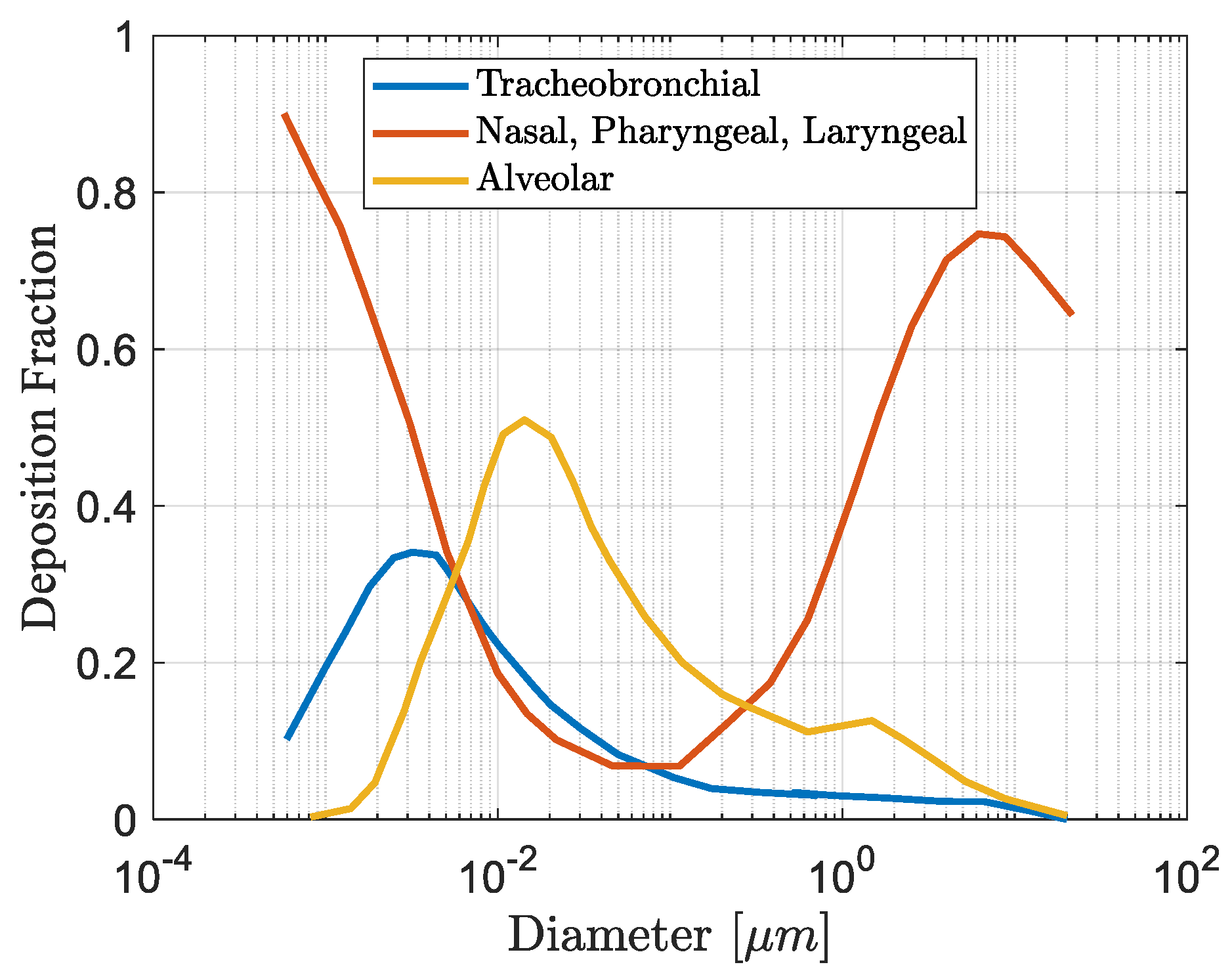
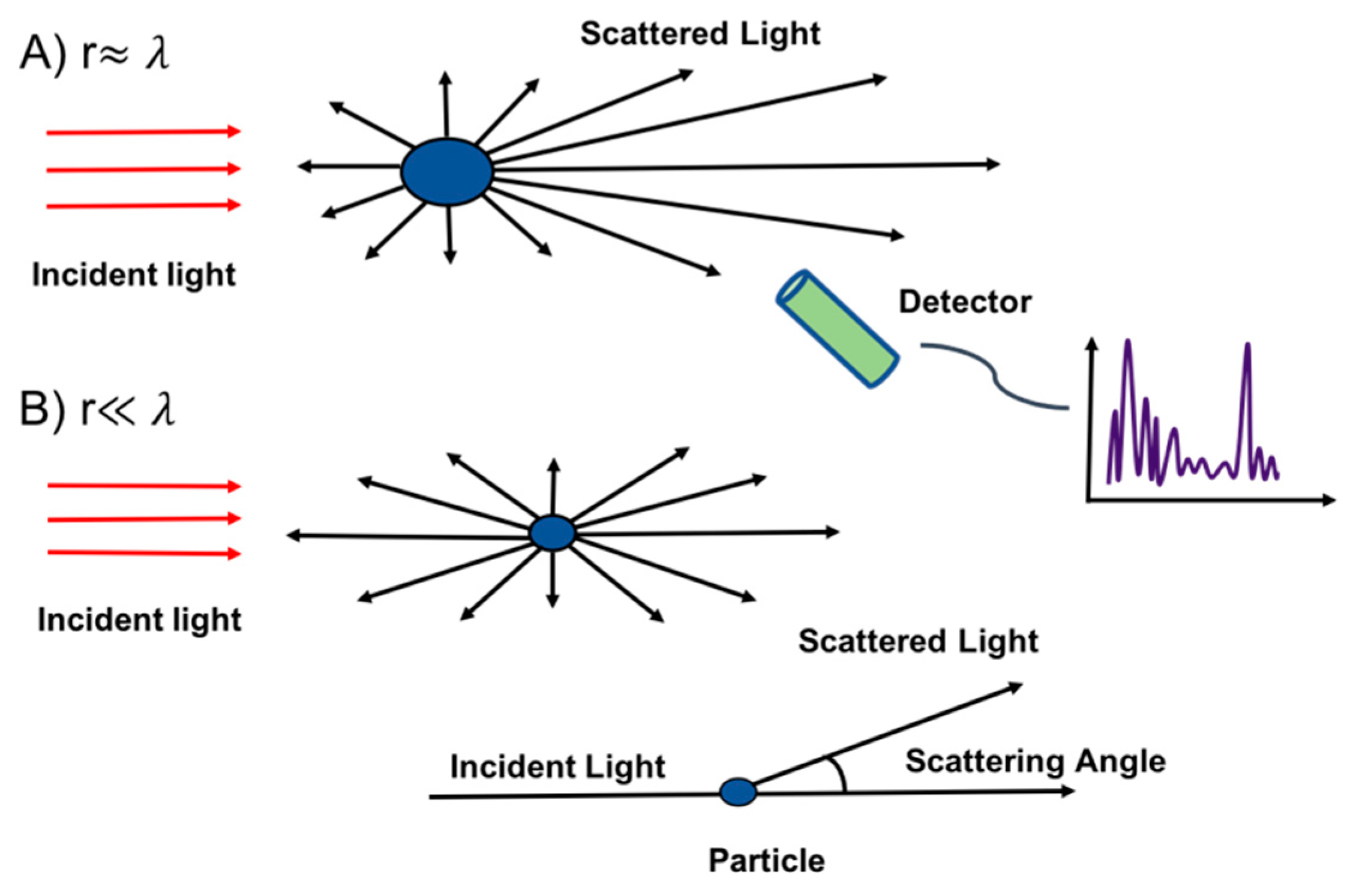
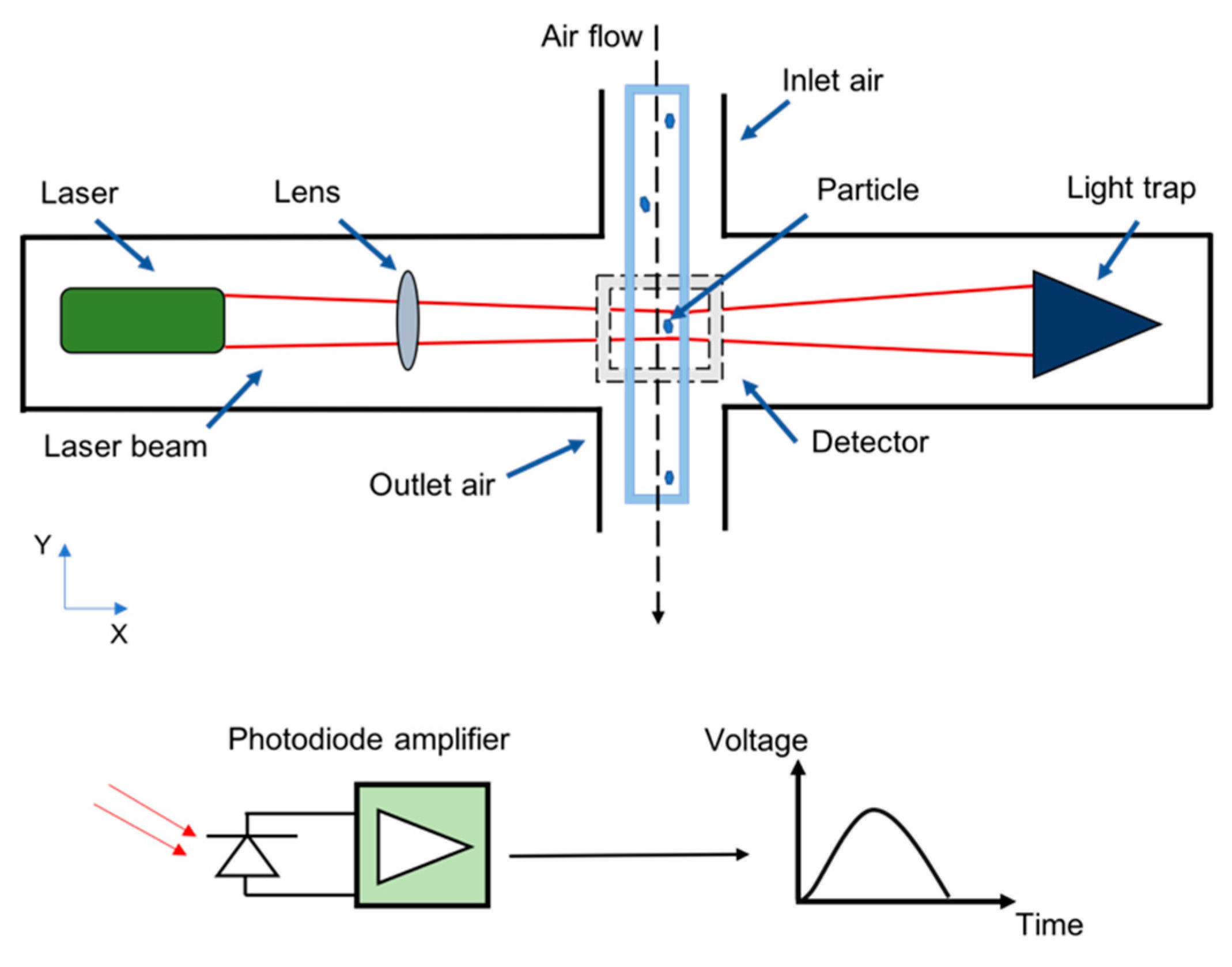
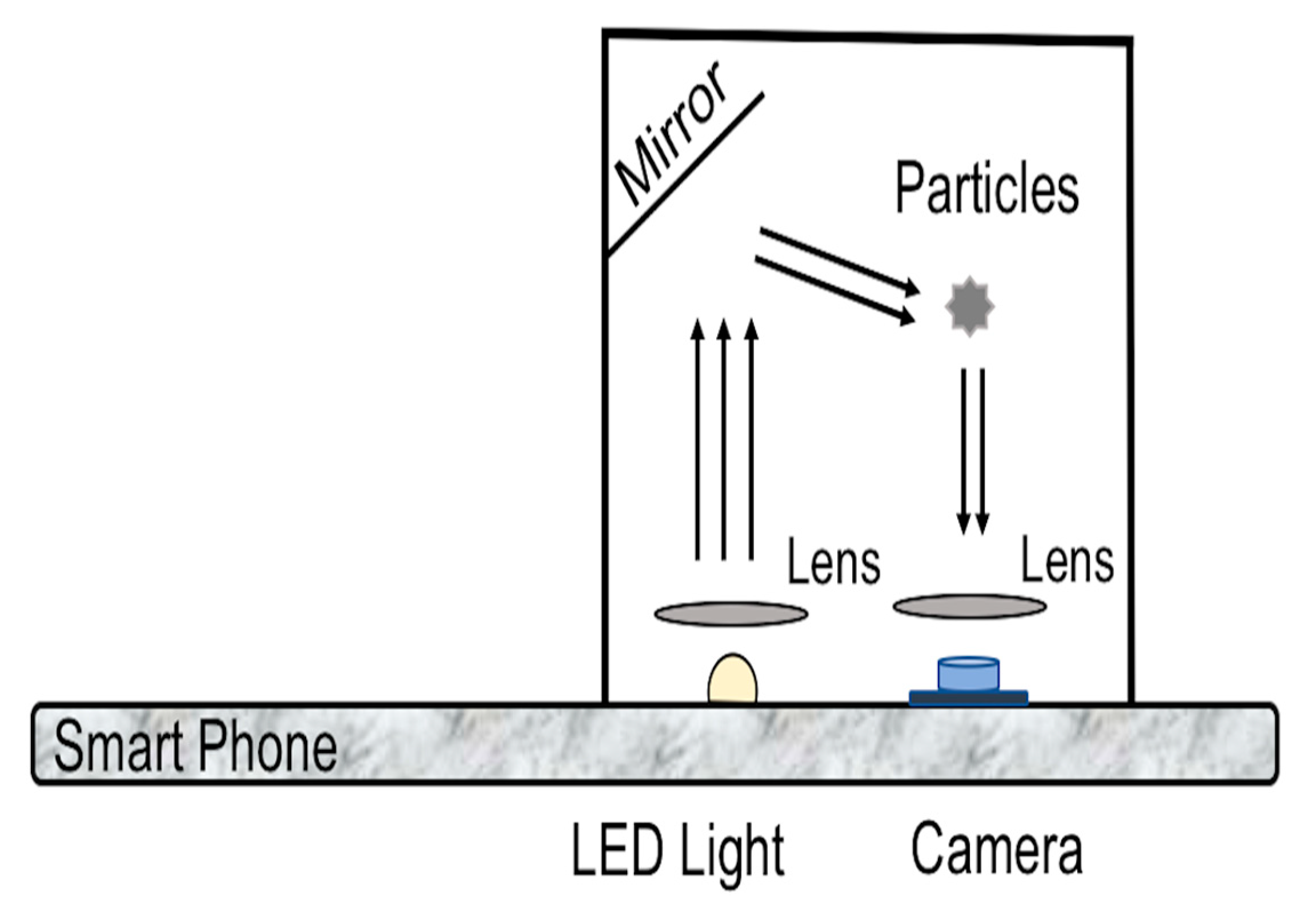
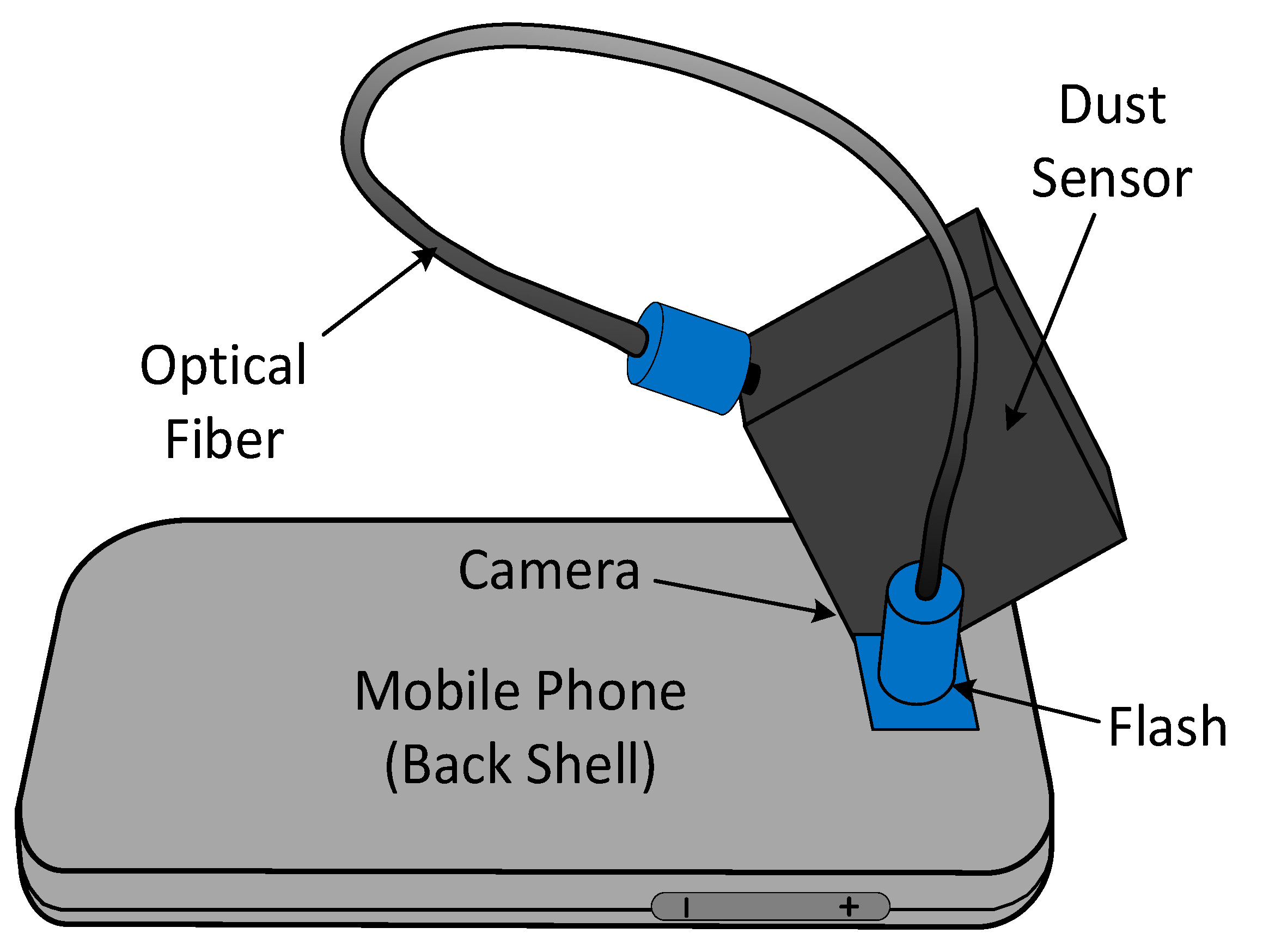
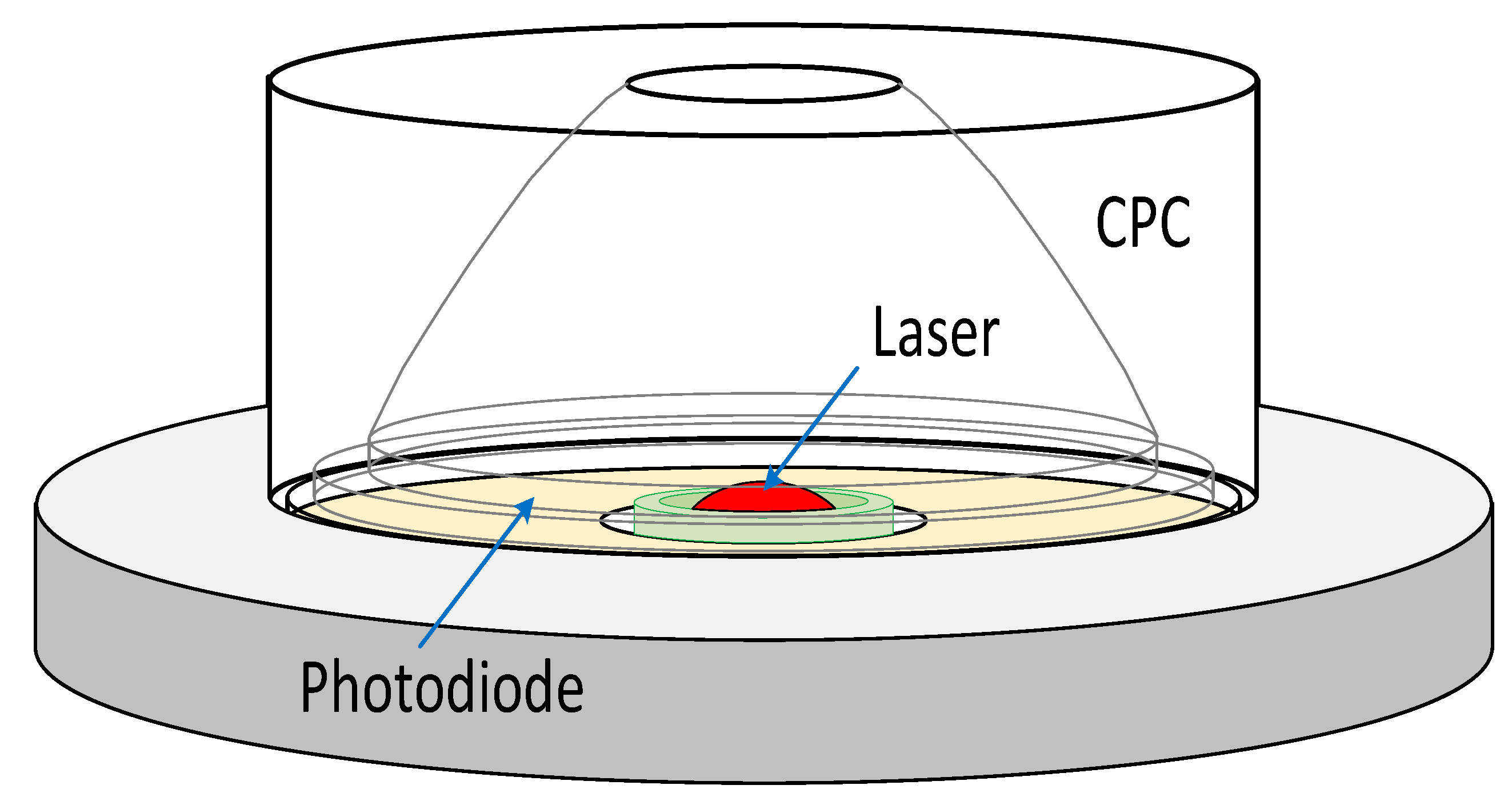
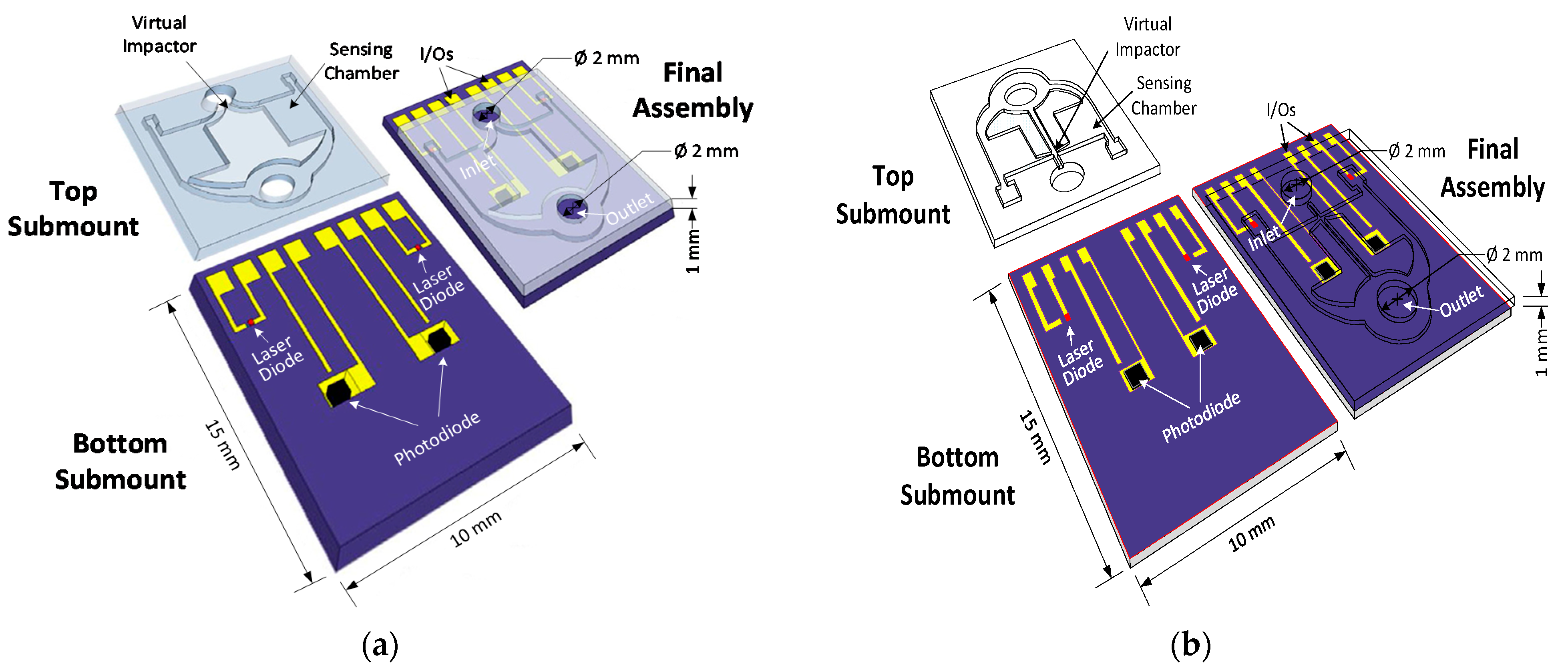
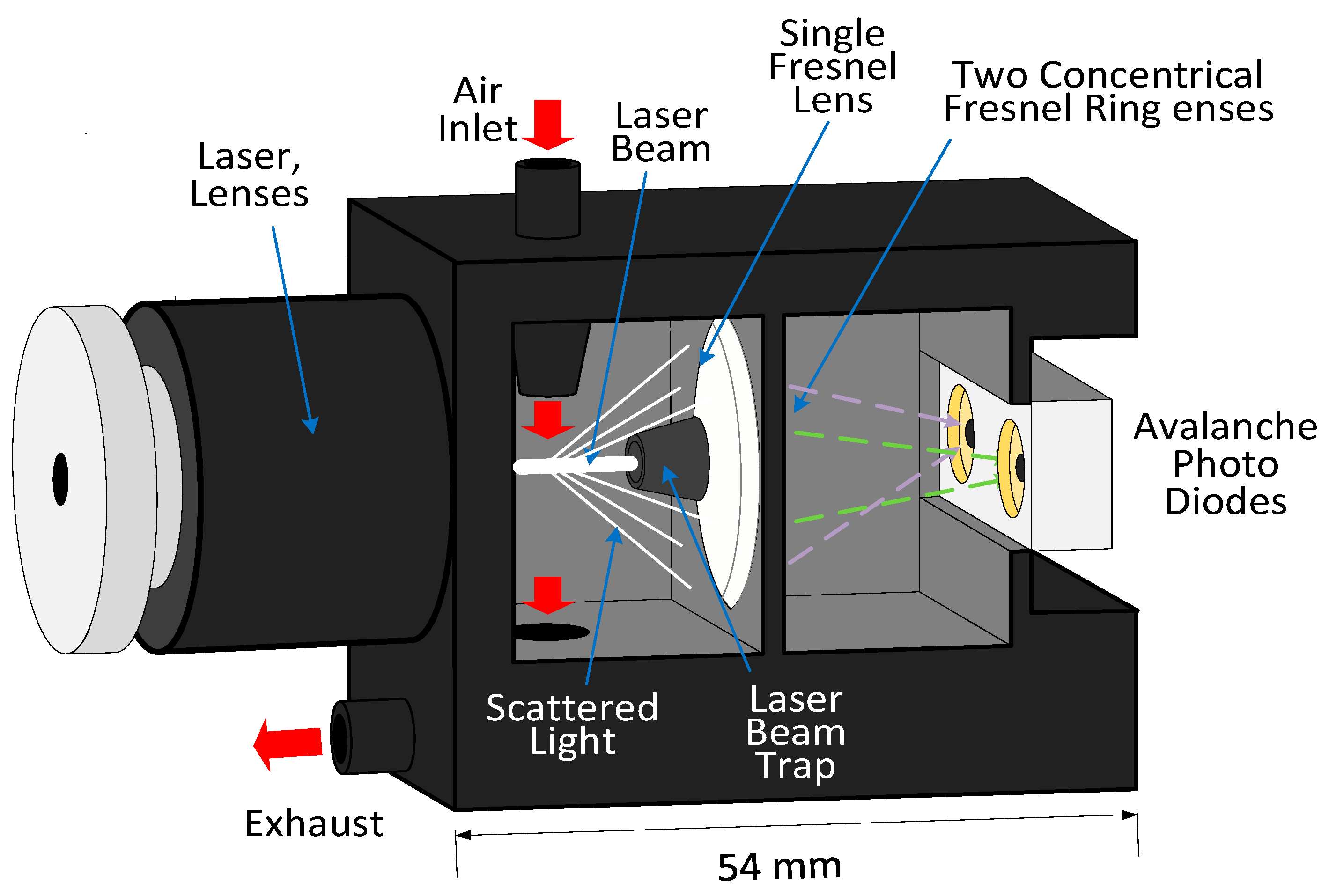
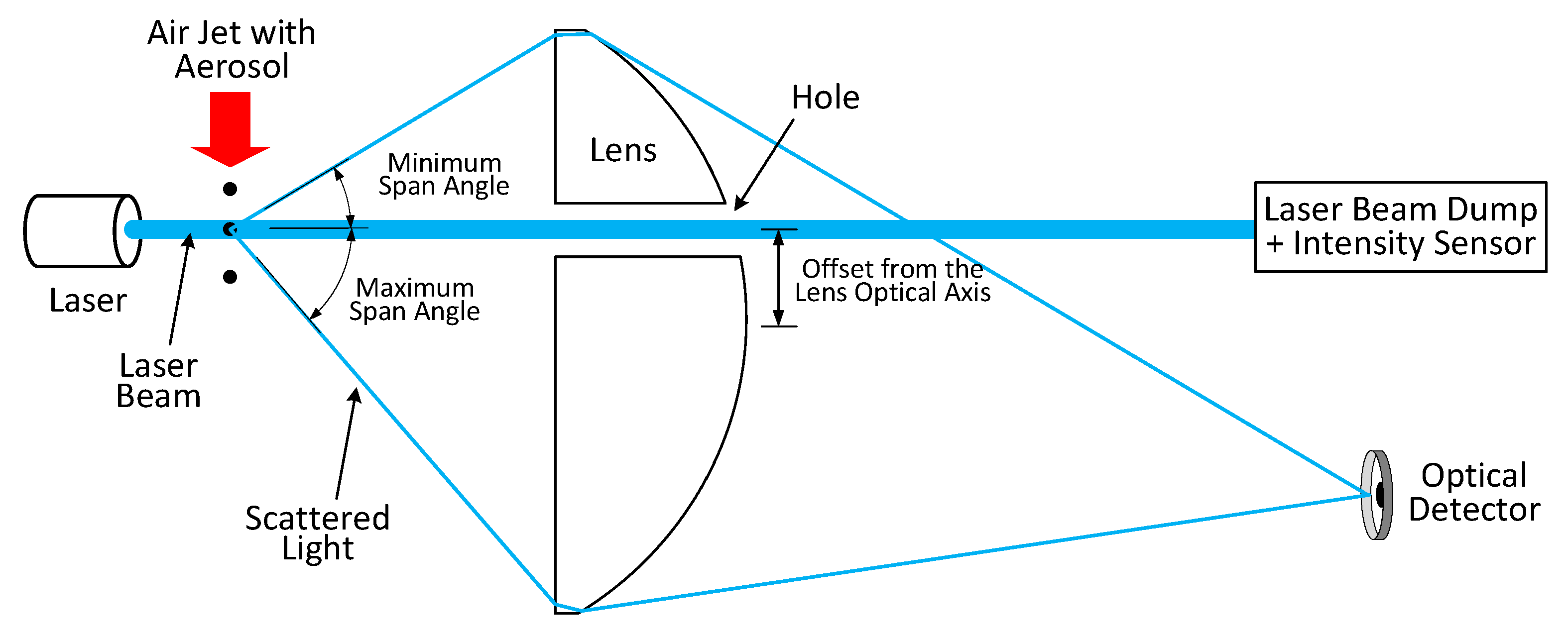
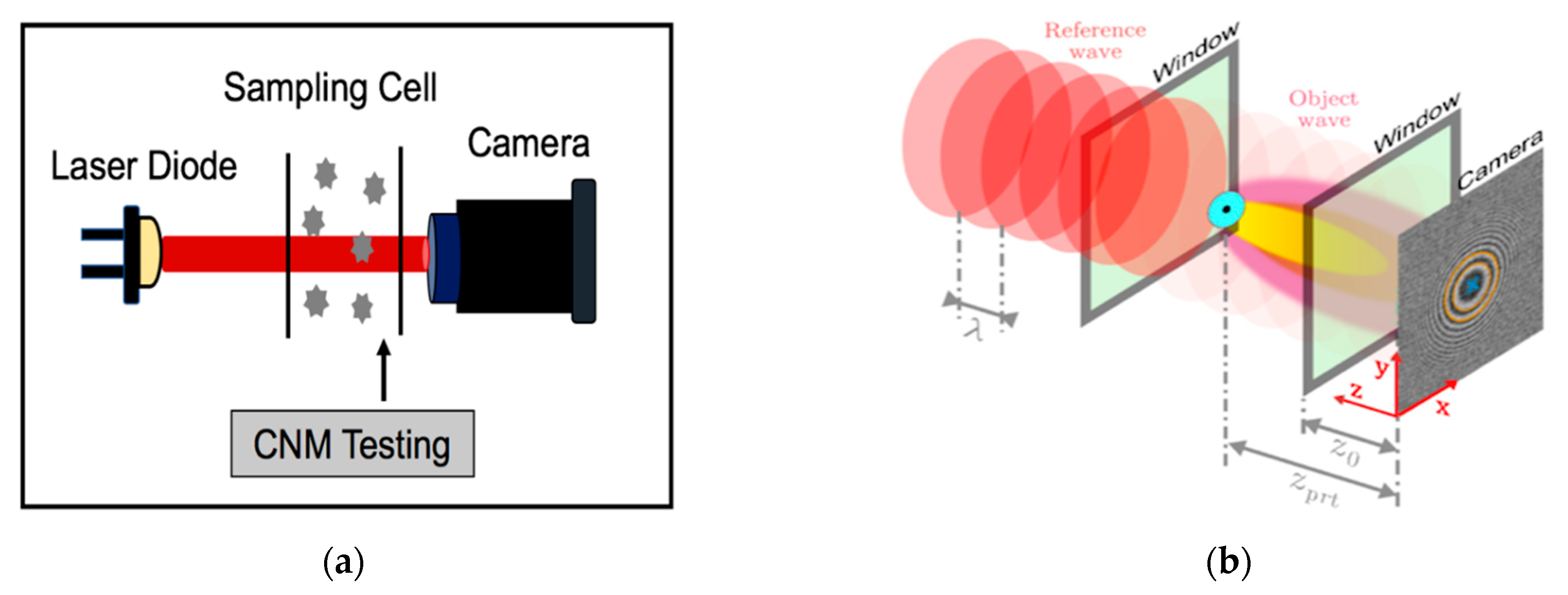
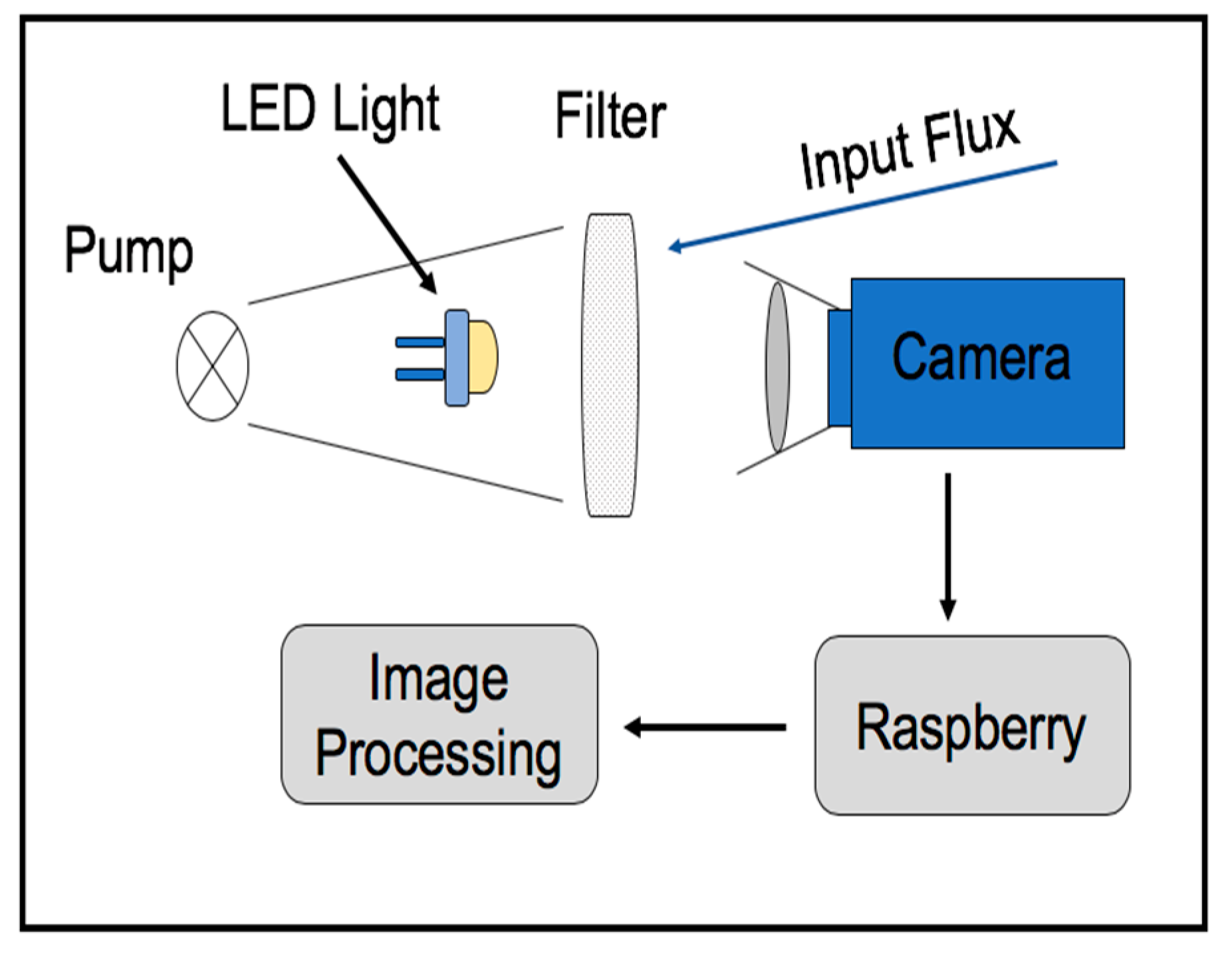
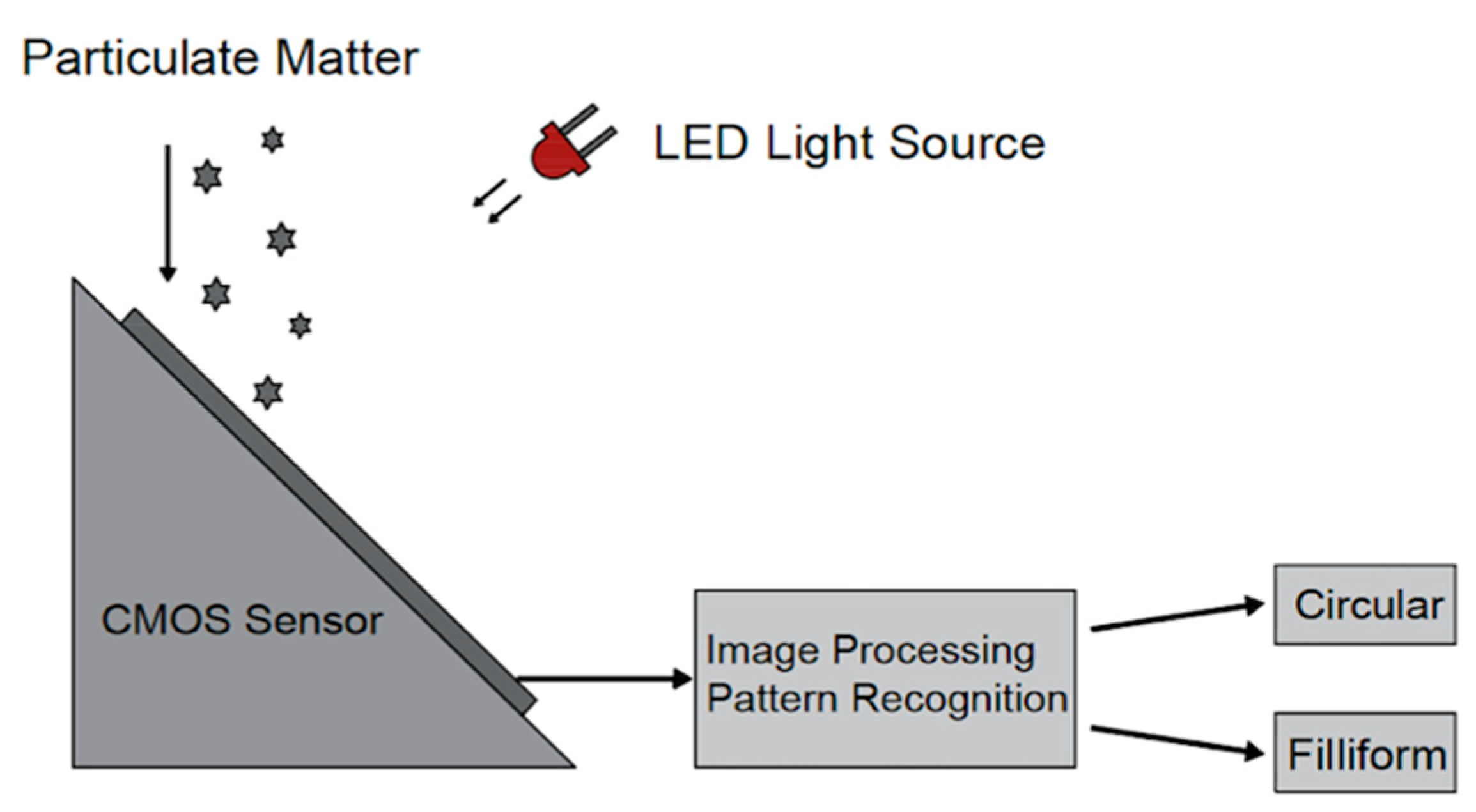
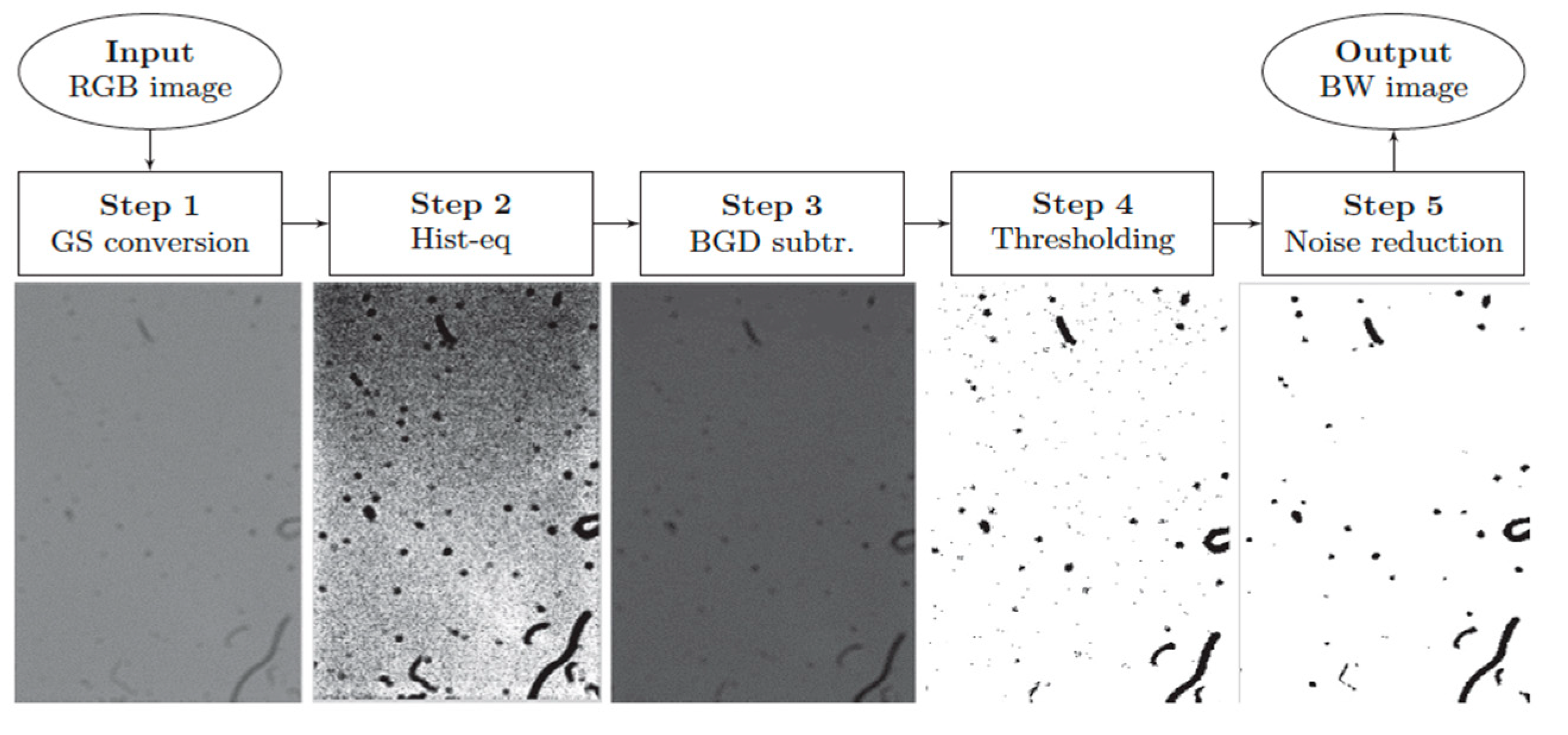
| Air Quality Standards | (Annual Mean) | (24-h Mean) | (Annual Mean) | (24-h Mean) |
|---|---|---|---|---|
| EPA | 15 ( | 35 ( | - | 150 ( |
| WHO | 10 ( | 25 ( | 20 ( | 50 ( |
| EU | 25 ( | - | 40 ( | 50 ( |
| 2012 NAAQS | 35 ( | 75 ( | 70 ( | 150 ( |
| Mobile, Low-Cost Optical Particle Sensors | |||
|---|---|---|---|
| Principle | Light Scattering Method (Mie Theory, Raleigh Theory) | Image Processing Methods | |
| Detection system | Photodiode | Camera | Camera |
| Examples | Commercial OPC | Smartphone based OPC | Holography sensors |
| OPC Based on Smart Phone | First Generation Sensor/Second Generation Sensor | Third Generation Sensor |
|---|---|---|
| Type of smart phone used in research | HTC smart phone(HTC Corporation, New Taipei, Taiwan)/Google Nexus 4 (LG Electronics, Seoul, South Korea) Android 2.3.3 | Galaxy S6 (Samsung Electronics, Seoul, South Korea) Android 7 |
| System design | Using optical fiber/Semi-spherical lens using optical fiber | Mirror-based using camera LED |
| Detection size | Coarse particle | Fine particle |
| Method of processing | Based on sum light scatter of the particles | Based on scatter traces of the particles (magnifier-based approach) |
| Processing approach | Poisson Particle Detection (PPD) algorithm | Combing the PPD algorithm and Contour Detection Particle Counting(CDPC) algorithm |
| Detection | Online detection | The data can analyses for further check of algorithm parameter |
| Camera position | In focal point of lens | Far from focal point of the lens |
| Dimension | Bulky and large dimension | Small dimension and easily install |
| Type of the Smartphone-Based OPC | Passive Design | Active Design |
|---|---|---|
| Structure | Depends on phone | Independent of phone |
| System hardware | Should be adopted for different phones | Use for wide range of smart phones |
| System control | Software implementation in phone | External control |
| Cost | Ultra-low cost | low cost |
| Light source | Insufficient intensity using flash of the phone | Sufficient light using external LED |
| Kind of Sensor | Working Principle | Detected PM Size Ranges | Minimum Resolution | Detection System | Reference System |
|---|---|---|---|---|---|
| CPC-based OPC | Light scattering | PM1 | 7.9 | Mass concentration | Dust track DRX TSI18533 |
| Silicon-based OPC | Light scattering | PM2.5 | 2.55 | Mass concentration | OPC 1.109 GRIMM |
| Drilled lens-basedOPC | Light scattering | PM2.5 (PM above 140) | _ | Mass concentration | Single particle soot photometer |
| Fresnel ring lens-based OPC | Light scattering | PM2.5 (PM above 125) | _ | Size detection/mass concentration | Grimm SMPS + C5.403 |
| Camera-based OPC | Light scattering +signal processing algorithm | PM10–2.5 | _ | Size detection/ mass concentration | SMPS/TSI APS |
| Holographic particle counter | Holography+ Image processing | PM above 3–4 after condensation | Singleframe: 4.16 () 20 fps: 0.208 () | Number Concentration | TSI-3775 |
| Camera filter-based sensor | Image processing | PM above 3 | _ | Size detection/ mass concentration | Commercial particulate monitoring station |
| CMOS sensor | Image processing | PM above 3 | _ | Size detection/shape | _ |
| Kind of Sensor | Light Detection | Detector | External Lens | Dimension |
|---|---|---|---|---|
| CPC-based OPC | Laser diode (635 ) | Five red-enhanced Si photodiode | CPC/20 °C acceptance angle | Miniaturized (11 25) |
| Silicon-based OPC | Laser diode (650) | Silicon PIN Photodiode | Collimating channel | Miniaturized (15 10 1) |
| Drilled lens-based OPC | Laser diode (405) | Photomultiplier | Aspheric lens with hole | Small (length: 300) |
| Fresnel ring lens-based OPC | Laser diode (450 ) | Two avalanche photodiodes | Fresnel ring lenses | Miniaturized (Measurement chamber: 54 ) |
| Camera-based OPC | Smartphone flash LED | Smartphone camera | Large magnification lens | Miniaturized (Depends on phone model) |
| Holographic particle counter | Laser diode (635) | UI-3082SE-M Camera IDS (COMS sensor) | _ | Small (Without CNM) |
| Camera filter-based sensor | 3RGBLED 1 IR LED 1 UVLED | RPI NOIR Camera V2 | Macro Lens 15 | Small |
| CMOS sensor | White LED | LifeCam HD-3000 (COMS sensor) | Without lens segment of camera | Small |
Publisher’s Note: MDPI stays neutral with regard to jurisdictional claims in published maps and institutional affiliations. |
© 2021 by the authors. Licensee MDPI, Basel, Switzerland. This article is an open access article distributed under the terms and conditions of the Creative Commons Attribution (CC BY) license (https://creativecommons.org/licenses/by/4.0/).
Share and Cite
Molaie, S.; Lino, P. Review of the Newly Developed, Mobile Optical Sensors for Real-Time Measurement of the Atmospheric Particulate Matter Concentration. Micromachines 2021, 12, 416. https://doi.org/10.3390/mi12040416
Molaie S, Lino P. Review of the Newly Developed, Mobile Optical Sensors for Real-Time Measurement of the Atmospheric Particulate Matter Concentration. Micromachines. 2021; 12(4):416. https://doi.org/10.3390/mi12040416
Chicago/Turabian StyleMolaie, Sama, and Paolo Lino. 2021. "Review of the Newly Developed, Mobile Optical Sensors for Real-Time Measurement of the Atmospheric Particulate Matter Concentration" Micromachines 12, no. 4: 416. https://doi.org/10.3390/mi12040416
APA StyleMolaie, S., & Lino, P. (2021). Review of the Newly Developed, Mobile Optical Sensors for Real-Time Measurement of the Atmospheric Particulate Matter Concentration. Micromachines, 12(4), 416. https://doi.org/10.3390/mi12040416






